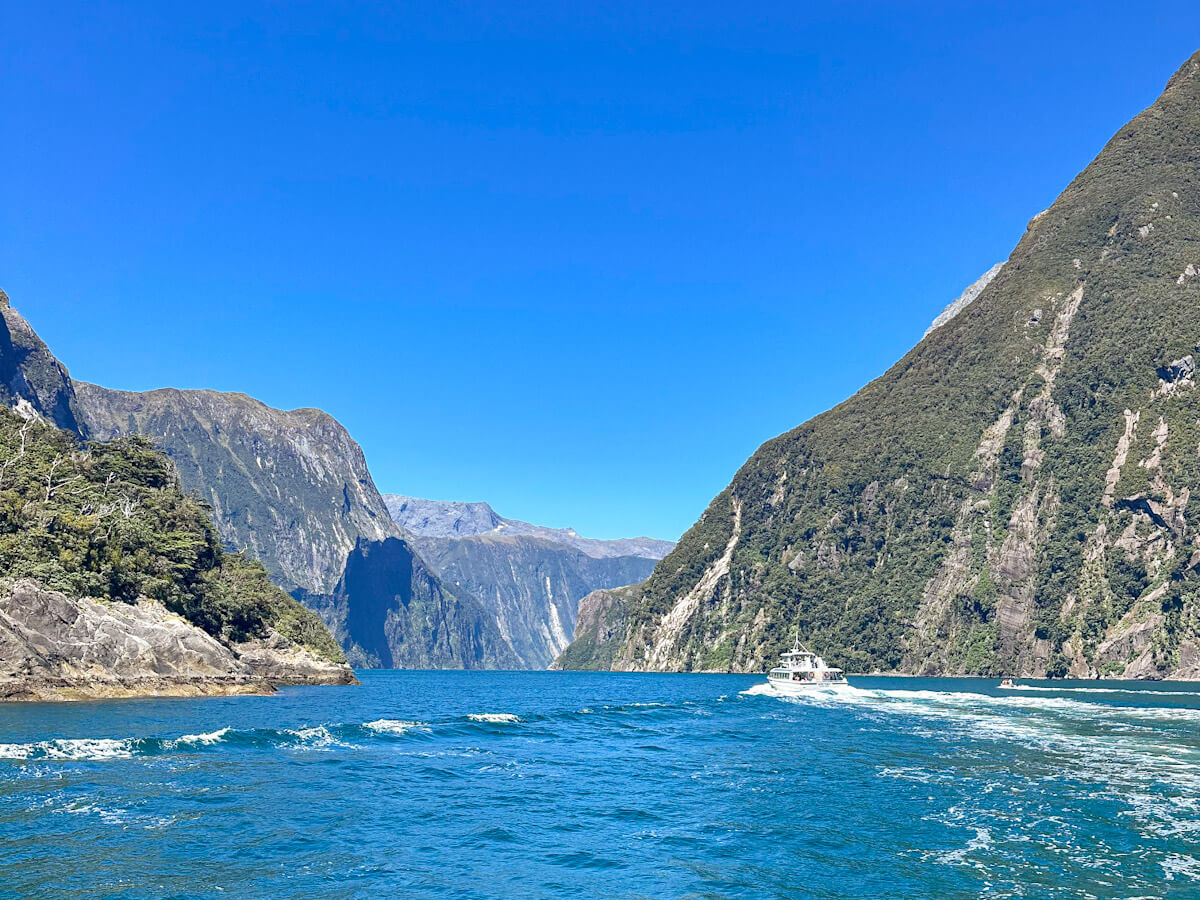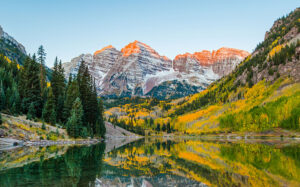Think of Milford Sound and Doubtful Sound as metaphors for life itself. These grandiose fiords are world-famous for their immense size and striking appearance, earning them the title “Eighth Wonders of the World.” But they didn’t start out this way—these magnificent natural formations took millions of years to create. Sometimes, the key to creating something grand is taking small steps every day. Over time, these subtle changes lead to something magnificent, even monumental. The very ground you walk on was shaped and shifted over millennia as land masses broke from super-continents to form the places we call home today. It was small geological steps like these that formed Milford and Doubtful Sound, and now these stunning New Zealand destinations stand as testament to nature’s patient artistry.
See why New Zealand’s most beautiful places are two can’t-miss destinations on your next trip to Kiwi country.
Fiordland National Park: Gateway to Wonder
Both Milford and Doubtful Sound are located in a region of New Zealand known as Fiordland National Park. The nearly 5,000 square miles of New Zealand’s south-west tip contains some of the most quintessential and incredible landscapes in the world, protected within this UNESCO World Heritage site.
When you think about New Zealand and the amazing scenery it’s known for, you’re probably envisioning two distinct landscapes: the rolling, grassy vistas popularized in movies like The Lord of the Rings, and tall, steep peaks shadowed by mist, rising above calm waters below.
The latter describes Fiordland perfectly. By far the two most visited places in Fiordland are Milford and Doubtful Sound, and for excellent reasons that become immediately apparent upon arrival.
The Geological Story Behind the Sounds
Over the course of millions of years, shifting tectonic plates caused tall rock formations to push up from beneath the sea. As the earth continued its slow-motion collision with itself, sharp peaks reached high into the air, creating the dramatic topography visible today.
During the ice age, massive glaciers formed and began to move across the landscape. Inch by inch, they slowly eroded rock and sediment, carving the narrow channels and deep valleys found in Fiordland today. These ancient rivers of ice sculpted the landscape into the breathtaking fiords that now attract hundreds of thousands of visitors annually.
Small steps. Big changes. This is the story written in stone throughout Fiordland National Park.
Milford Sound: New Zealand’s Most Famous Fiord
Sometimes it’s the journey. Other times it’s the destination. When it comes to Milford Sound, it’s both—a philosophy that defines the entire experience of visiting this natural wonder.
The Scenic Drive to Milford Sound
The scenic drive from Queenstown is like a “best-of” tour of New Zealand’s pristine landscapes. You’ll drive along winding roads that hug Lake Wakatipu, a turquoise-blue, glacier-fed lake that seems to glow in the sunlight.
Stop along any of the pull-outs and viewing points along the way and you might recognize the vast expanse of water rimmed by mountains. On the big screen, it served as the backdrop for Middle Earth in several scenes of The Lord of the Rings, making it a pilgrimage site for fans of the films.
As you enter New Zealand hill country, tall mountains give way to grass-covered, wavy hills and colorful lupins line the highway, creating a patchwork of natural beauty that changes with every turn.
This scenic highway is precisely why Milford Sound is New Zealand’s most accessible and most visited site in Fiordland.
Travel Tip: Want to skip the traffic on the way back? Consider a Milford Sound Cruise and Scenic Flight. Return from your cruise in style on a scenic plane journey back to Queenstown, offering aerial perspectives of the landscapes you just explored.
Why Milford Sound Attracts 600,000 Visitors Annually
Every year nearly 600,000 tourists come to Milford Sound, taking advantage of the highway leading there. This accessibility makes it easy to take a day trip from the populous city of Queenstown, or a quick stopover if you make your base in Te Anau, the gateway town to Fiordland.
And it’s easy to understand why once you arrive. Although the word “epic” may be overused in travel writing, there is no better way to describe Milford Sound.
The tall, steep crags jut dramatically out of the water, peaking high overhead. It’s home to the tallest peak in Fiordland, Mitre Peak, reaching into the sky nearly 6,000 feet. This iconic landscape has single-handedly attracted visitors from across the globe, appearing in countless photographs and travel documentaries.
Managing Crowds at Milford Sound
An increase in visitors also means an increase in the number of boats cruising the Sound to accommodate them. On Milford Sound, you’re in the company of numerous different tour boats, operators and cruise ships, all seeking to see the same spectacular sites.
However, this doesn’t mean you’re surrounded by raging party-boats. Most operators maintain respectful silence during key moments. Still, nothing beats the ambiance of feeling alone on the water, a mere speck among rocky skyscrapers towering overhead—an experience more readily found at its neighboring fiord.
Doubtful Sound: The Road Less Traveled
If silent ambiance is your prime objective when visiting a natural wonder, look no further than Doubtful Sound. This is the slightly less popular younger sibling to Milford Sound—it doesn’t have quite the same name recognition, it’s a little harder to reach, and the peaks aren’t quite as dramatically tall.
But being more remote proves beneficial to the unmatched ambiance found at Doubtful Sound.
Accessing Doubtful Sound
Access to Doubtful Sound is limited to a ferry ride over Lake Manapouri, followed by a bus journey across Wilmot Pass. You won’t find the rows of coaches, buses and cars that crowd Milford. Instead, a very limited number of boats cruise through this beautiful fiord, maintaining the pristine character of the environment.
This makes Doubtful Sound a slightly more solemn excursion, perfect if you’re seeking a true “one-with-nature” type of experience. The limited access ensures that visitor numbers remain sustainable and the natural ambiance stays intact.
The Character of Doubtful Sound
The rocky cliffs that arise from Doubtful Sound apex at a rounded crest, as opposed to Milford’s angular, jagged peaks. Soft, green ferns and lush forest cover much of the mountainous rises, and foggy mist often rests like pillows in the treetops, creating an ethereal atmosphere.
Doubtful Sound is also significantly larger than Milford, stretching over 40 kilometers with multiple arms and reaches to explore. This means more territory to cover and more solitude to experience during your visit.
But the main attraction at both Milford and Doubtful Sounds isn’t what you see—it’s what you hear.
The Sound of Silence: A Unique Natural Experience
Much like the world’s other natural wonders, Milford and Doubtful Sound have the power to leave you speechless. If you’ve ever been to the Grand Canyon, you’ll know that upon reaching the rim, there’s a distinct shift that happens.
All the usual chatter that fills the parking lot—families swapping stories of the road and siblings arguing over who won the “License Plate Game”—seems to disappear upon arrival.
Looking into the void that Earth created renders an eerie hush where you could almost hear a pin drop all the way in the valley below.
Maybe it’s the overwhelming sense of your place on the planet, or maybe no one wants to break the silence and ruin the mood. In any case, it’s an experience unique to witnessing something so grand that an entire crowd is left searching for words.
The Signature “Sound of Silence” Cruise Experience
At Milford and Doubtful Sounds, you’ll experience that same majestic sound-of-nothing from the water itself, on a “sound of silence” cruise. You’ll navigate through the giant fiords, craning your neck to take in the enormous rock formations standing tall around the still water.
As you reach a center point in the great fiord, the captain of the ship turns off the engines. Then, all you’re left with is the soft babble of water and the distant call of birdsong echoing off canyon walls.
The captain doesn’t need to call for silence—passengers instinctively understand the reverence the moment demands. In this profound quiet, you can hear waterfalls cascading from heights measured in hundreds of feet, the occasional splash of dolphins or seals breaking the surface, and the whisper of wind through ancient rock corridors.
It’s a moment of pure connection with nature that few places on Earth can provide.
Wildlife Encounters in the Sounds
Both Milford and Doubtful Sound are home to remarkable wildlife populations. Bottlenose dolphins are frequently spotted, particularly in Doubtful Sound where a resident pod of around 60 individuals lives year-round.
Fur seals sun themselves on rocks at the entrance to both sounds, and the rare Fiordland crested penguin can occasionally be glimpsed during breeding season. Above, you might spot albatross, shags, and other seabirds riding thermal currents between the peaks.
Beneath the surface, black coral grows in the dark waters—ironically named, as the living coral is actually white, turning black only when dried. These ancient coral colonies can live for hundreds of years, thriving in the unusual conditions created by the fiord’s unique water layers.
Weather and What to Expect
Fiordland is one of the wettest places on Earth, receiving over 7 meters of rainfall annually in some areas. This extraordinary precipitation is what creates the hundreds of temporary waterfalls that cascade down the fiord walls after rain, one of the most spectacular sights you can witness.
Visitors should come prepared for all weather conditions. Rain gear is essential, as is layered clothing since temperatures can fluctuate significantly throughout the day. However, the rain shouldn’t deter you—many visitors argue that Milford and Doubtful Sound are at their most dramatic during or immediately after rainfall.
The frequent rain also means that clear days are treasured. When sunshine breaks through, it illuminates the landscape in ways that seem almost unreal, with light dancing off waterfalls and reflecting in the dark waters below.
Best Time to Visit
Milford and Doubtful Sound can be visited year-round, though each season offers different experiences.
Summer (December-February) brings the most visitors and the longest days, with temperatures reaching the mid-60s Fahrenheit. This is peak season, so expect more crowds and higher prices.
Autumn (March-May) offers beautiful light and fewer tourists as the season winds down. Temperatures are still comfortable, and the changing foliage adds warm colors to the landscape.
Winter (June-August) sees the fewest visitors and often brings snow to the mountain peaks, creating stunning contrast. The drive to Milford can be challenging during this season, with chains sometimes required.
Spring (September-November) showcases abundant waterfalls from snowmelt and spring rains, plus awakening wildlife. This shoulder season offers good value and moderate crowds.
Accommodation Options
For those wanting to extend their visit, Te Anau serves as the primary gateway town to Fiordland, offering a range of accommodation from backpacker hostels to luxury lodges. The town sits on beautiful Lake Te Anau and provides a comfortable base for exploring the region.
Queenstown, while farther away, offers the widest selection of hotels, restaurants, and activities. Many visitors choose to stay here and take day trips to Milford Sound.
For a truly unique experience, overnight cruises on Doubtful Sound are available, allowing you to experience the fiord at its most peaceful—during the magical hours of dusk and dawn when day-trippers have departed.
Planning Your Visit
Both sounds require some advance planning. Milford Sound is accessible year-round by road (weather permitting), while Doubtful Sound requires booking with an operator who can arrange the ferry and bus transfers necessary to reach the embarkation point.
Scenic flights from Queenstown offer another perspective entirely, providing aerial views that showcase just how dramatic and extensive the Fiordland region truly is. These flights can be combined with cruises for a comprehensive experience.
Most visitors allocate a full day for Milford Sound and another full day for Doubtful Sound if time permits. This allows for the round-trip journey plus several hours exploring each fiord by boat.
Find more breathtaking natural wonders, travel planning guides, and destination inspiration at The Inspiring Insight—where we celebrate the extraordinary places that remind us of our planet’s patient, powerful beauty and the importance of preserving these treasures for future generations.


